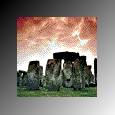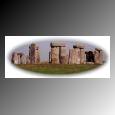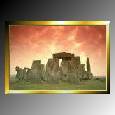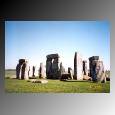Stonehenge consists of four concentric ranges of stones. In the outermost range, large
rectangular sandstone blocks (sarsen stones), 4 m (13 ft) high above the ground,
form a circle 33 m (108 ft) in diameter; they were originally capped with lintel
stones (only a few of which remain in place today) that also formed a continuous
circle. Within this outer range is a circle of smaller bluestones (consisting
mainly of dolerite, a coarse basaltic rock having a bluish colour). They enclose
a horseshoe-shaped arrangement of bluestones capped with lintels. These
trilithons (an assemblage of two uprights capped by a lintel) are 6.5 m (21 ft)
high. Within the trilithons stands a slab of micaceous sandstone known as the
Altar Stone.
The entire assemblage is surrounded by a circular ditch 104 m (340 ft) in diameter.
On its inner side the ditch rises into a bank within which is a ring of 56 pits
known as Aubrey holes (after their discoverer, the antiquarian John Aubrey) and
used at a later stage as cremation burial pits. On the north-eastern side, the
bank and ditch are intersected by the Avenue, a processional causeway 23 m (75
ft) wide and nearly 3 km (2 mi) long, bordered by a ditch. Near the entrance to
the Avenue is the Slaughter Stone, a sarsen stone that may originally have stood
upright. Almost opposite, and set within the Avenue, is the Heel Stone, which
may have played a part in sightings of the sunrise at the summer solstice.





Stonehenge
History
of Stonehenge
Calendrical
Theory




